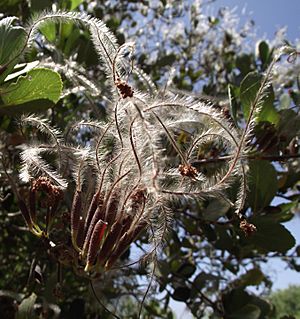Birchleaf mountain-mahogany facts for kids
Quick facts for kids Birchleaf mountain-mahogany |
|
|---|---|
 |
|
| var. blancheae in fruit | |
| Scientific classification | |
| Genus: |
Cercocarpus
|
| Species: |
betuloides
|
 |
|
| Natural range of Cercocarpus betuloides | |
| Synonyms | |
|
Cercocarpus montanus var. glaber (S. Watson) F.L. Martin |
|
Cercocarpus betuloides is a type of shrub or small tree. It belongs to the rose family, just like roses! People often call it mountain mahogany or birch leaf mountain mahogany. It gets the name "mahogany" because its wood is very hard and has a reddish color. But don't be fooled, it's not a true mahogany tree.
Contents
Where Does It Grow?
This plant is native to several places. You can find it in California, Baja California (which is in Mexico), Oregon, Arizona, and parts of New Mexico. It loves to grow in areas that are dry in the summer. You'll often see it in the foothills and mountains of California. It's a common plant in areas called chaparral, which are like natural shrublands.
What Does It Look Like?
How It Grows
Cercocarpus betuloides can be a shrub or a small tree. It can grow from about 3 feet (1 meter) tall to as tall as 30 feet (9 meters)! Its branches look strong and muscular from the side. If you cut a branch and look at it, it would have a bumpy, lobed shape. This plant often grows alongside other shrubs like toyon in chaparral areas.
Leaves and Stems
The leaves of this plant are quite special. The bottom half of the leaf has smooth edges. But the top half has wavy or slightly toothed edges, leading to a rounded tip. The name betuloides means "like birch". This is because its leaves look a bit like those of a birch tree.
Flowers and Fruit
The flowers of Cercocarpus betuloides are small and white. They grow in clusters and have a light, pleasant smell, similar to acacia flowers. After the flowers, the plant produces a unique fruit. It's a small, tube-shaped fruit with a long, feathery "tail" still attached. This "tail" is actually part of the flower that stays on the fruit. The name of the genus, Cercocarpus, comes from two Greek words: kerkos meaning "tail" and carpus meaning "fruit". So, it literally means "fruit with a tail"!
Different Types
There are three main types, or varieties, of Cercocarpus betuloides:
- Cercocarpus betuloides var. betuloides: This type is found across the plant's whole natural range.
- Cercocarpus betuloides var. blancheae: This one is called Catalina mahogany or island mountain mahogany. It mostly grows in California, especially on the Channel Islands.
- Cercocarpus betuloides var. macrourus: Known as few flowered mountain mahogany, this type is found in California and Oregon.
Sometimes, Cercocarpus betuloides is considered a part of another plant, Cercocarpus montanus, especially the type called var. glaber.
How People and Animals Use It
Many animals enjoy eating this plant. Deer, cattle, and sheep often browse on its leaves and branches. The wood of this shrub is very hard and has a reddish color. Long ago, the indigenous peoples of California used this tough wood. They made useful tools like arrow tips, fishing spears, and digging sticks from it.
Today, Cercocarpus betuloides is also grown as an ornamental plant in gardens. Special nurseries sell it for planting in native plant gardens. It's great for drought tolerant gardens because it doesn't need much water. It's also used in wildlife gardens and projects that aim to restore natural habitats.
See also
 In Spanish: Cercocarpus betuloides para niños
In Spanish: Cercocarpus betuloides para niños

